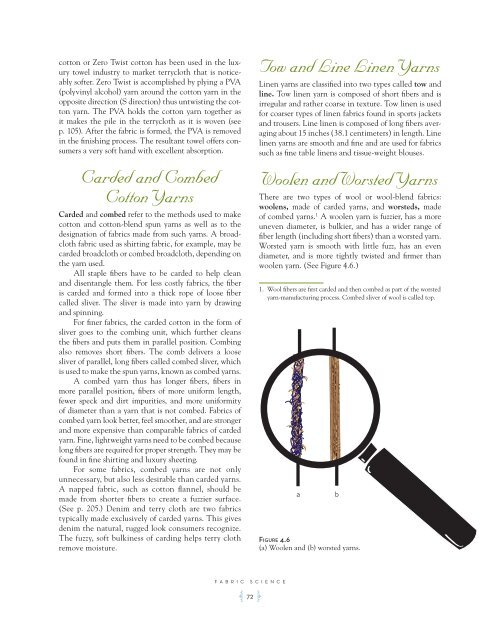Create successful ePaper yourself
Turn your PDF publications into a flip-book with our unique Google optimized e-Paper software.
cotton or Zero Twist cotton has been used in the luxury<br />
towel industry to market terrycloth that is noticeably<br />
softer. Zero Twist is accomplished by plying a PVA<br />
(polyvinyl alcohol) yarn around the cotton yarn in the<br />
opposite direction (S direction) thus untwisting the cotton<br />
yarn. The PVA holds the cotton yarn together as<br />
it makes the pile in the terrycloth as it is woven (see<br />
p. 105). After the fabric is formed, the PVA is removed<br />
in the finishing process. The resultant towel offers consumers<br />
a very soft hand with excellent absorption.<br />
Carded and Combed<br />
Cotton Yarns<br />
Carded and combed refer to the methods used to make<br />
cotton and cotton-blend spun yarns as well as to the<br />
designation of fabrics made from such yarns. A broadcloth<br />
fabric used as shirting fabric, for example, may be<br />
carded broadcloth or combed broadcloth, depending on<br />
the yarn used.<br />
All staple fibers have to be carded to help clean<br />
and disentangle them. For less costly fabrics, the fiber<br />
is carded and formed into a thick rope of loose fiber<br />
called sliver. The sliver is made into yarn by drawing<br />
and spinning.<br />
For finer fabrics, the carded cotton in the form of<br />
sliver goes to the combing unit, which further cleans<br />
the fibers and puts them in parallel position. Combing<br />
also removes short fibers. The comb delivers a loose<br />
sliver of parallel, long fibers called combed sliver, which<br />
is used to make the spun yarns, known as combed yarns.<br />
A combed yarn thus has longer fibers, fibers in<br />
more parallel position, fibers of more uniform length,<br />
fewer speck and dirt impurities, and more uniformity<br />
of diameter than a yarn that is not combed. <strong>Fabrics</strong> of<br />
combed yarn look better, feel smoother, and are stronger<br />
and more expensive than comparable fabrics of carded<br />
yarn. Fine, lightweight yarns need to be combed because<br />
long fibers are required for proper strength. They may be<br />
found in fine shirting and luxury sheeting.<br />
For some fabrics, combed yarns are not only<br />
unnecessary, but also less desirable than carded yarns.<br />
A napped fabric, such as cotton flannel, should be<br />
made from shorter fibers to create a fuzzier surface.<br />
(See p. 205.) Denim and terry cloth are two fabrics<br />
typically made exclusively of carded yarns. This gives<br />
denim the natural, rugged look consumers recognize.<br />
The fuzzy, soft bulkiness of carding helps terry cloth<br />
remove moisture.<br />
FABRIC SCIENCE<br />
A 72 F<br />
Tow and Line Linen Yarns<br />
Linen yarns are classified into two types called tow and<br />
line. Tow linen yarn is composed of short fibers and is<br />
irregular and rather coarse in texture. Tow linen is used<br />
for coarser types of linen fabrics found in sports jackets<br />
and trousers. Line linen is composed of long fibers averaging<br />
about 15 inches (38.1 centimeters) in length. Line<br />
linen yarns are smooth and fine and are used for fabrics<br />
such as fine table linens and tissue-weight blouses.<br />
Woolen and Worsted Yarns<br />
There are two types of wool or wool-blend fabrics:<br />
woolens, made of carded yarns, and worsteds, made<br />
of combed yarns. 1 A woolen yarn is fuzzier, has a more<br />
uneven diameter, is bulkier, and has a wider range of<br />
fiber length (including short fibers) than a worsted yarn.<br />
Worsted yarn is smooth with little fuzz, has an even<br />
diameter, and is more tightly twisted and firmer than<br />
woolen yarn. (See Figure 4.6.)<br />
1. Wool fibers are first carded and then combed as part of the worsted<br />
yarn-manufacturing process. Combed sliver of wool is called top.<br />
a b<br />
Figure 4.6<br />
(a) Woolen and (b) worsted yarns.













